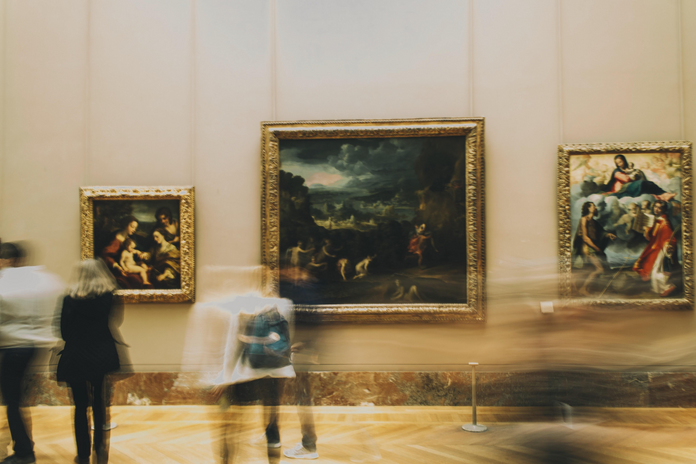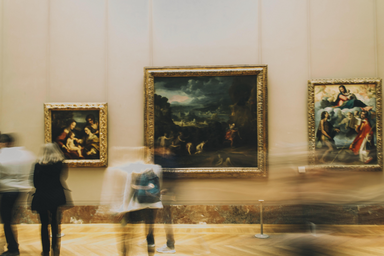You walk into a museum, you see an artwork you like, snap a photo with or of it, and you post it on Instagram. Now, there is nothing wrong with that. In fact, I’ll be the first to admit that I do post pictures of art on social media. So what did I mean when I so blatantly stated that art is not an aesthetic? Let’s walk through this.
Compared to before, more museums and galleries now allow photography. That’s good news for many as we get to store our own digital collection of artworks which we love (we can thank the rise of social media for that). Museums and galleries have become more open and accessible to the public as more visitors flow through their doors. People can now snap a photograph of a Renoir or a Rembrandt with ease (no more eagle eyed camera security watching your every move).
Less famous artists find themselves, however, on the losing end as people do not innately appreciate their art. Instead, they look past its meaning and go for its aesthetic instead. Contemporary artworks very often sit in budding galleries. Instead of having their work appreciated and sold, they become a backdrop for someone’s profile photo or social media post.
When Yayoi Kusama’s artworks arrived on Singapore shores, huge throngs of visitors flocked to the National Gallery. Her work, Infinity Mirrored Room – Gleaming Lights of the Souls was the exhibition’s most popular installation. I was in the gallery at the time of the exhibition, but was visiting the gallery’s permanent exhibition. The close to 1 hour 20 minute wait time to the exhibition space was beyond me. Curious about what was going on in the room that had such a long wait time, I poked my head through the doors. Needless to say, almost everyone had their phone out. Again, nothing wrong with that. But, there were people with their shoes glued to the ground snapping photo after photo. I doubt that anyone who appreciates art would be worrying about how they look in a photograph.
The gallery did not see the same amount of visitors a month later when the Impressionists were featured in the exhibition titled COLOURS OF IMPRESSIONISM: MASTERPIECES FROM THE MUSÉE D’ORSAY. I would know. I was there. Compared to the more “loud”, colour induced polka dot works of Kusama, the muted, “traditional” works of the Impressionists pale in comparison. Naturally, you’d find more Kusama works featured on social media as well.
“Visitors to art exhibitions in museums and galleries are not only to appreciate works of art, but some are more interested in getting objects to take selfies.”
Hariyanto, Art and Design Department, Universitas Negeri Malang, Malang, Indonesia
Another famous exhibition at the STPI – Creative Workshop & Gallery featured another prominent Japanese artist. Takashi Murakami. Objectively, people would take pictures of his artworks because they are iconic and because they liked it. People appreciate his artworks. But another group of people would seem to be there just for the glossy flower wallpaper adorning the gallery walls. Walking right past the exhibition summary, they would head straight to the walls or the in-your-face neon signs for a photoshoot. Oftentimes, they only went there for a photoshoot. Most of them would walk out without knowing what the exhibition was about. Visitors would take selfies aimlessly, sometimes even causing accidents. In the case of several women visiting an exhibition in New York, works by renowned and celebrated Surrealist Salvador Dali went crashing down to the floor after one of them leaned too far back in an attempt at a cute selfie. At the end of the day, when you ask them what they’ve seen in their visit to the exhibition, their answer would not be substantial.
Social media changes the way visitors interact with artworks. There are interactive exhibits, whose purpose is to engage visitors through touch or a mobile device; but other times, social media acts as a hindrance because instead of standing in front of an artwork to have an intimate moment with it – looking at it as a whole, zooming in on details, brushwork, texture, form – we decide that “it’ll make such an aesthetic photo!” Before proceeding to hog the entire artwork, while other visitors awkwardly avoid the camera lens by ducking out of the frame.
As an intern at a local gallery when I was in art school, I’ve seen it all. Very well-dressed visitors would come into the gallery, have a little fun photoshoot, and head out. Those that would come in to do photoshoots could be seen at more aesthetic looking exhibitions. For example, rather than appreciating the paintings mounted on a plain wall, people flock to artwork hanging from the ceiling, because the latter just looks more exciting. The curator would have set the exhibition according to a purpose, but the social media visitor would see it as nothing more than a photoshoot opportunity.
So where do we draw the line between appreciating art and using it as an Instagram backdrop? I would argue that there isn’t a line. We couldn’t have drawn it because everyone simply has different views on art. Even art itself is abstract. But the next time you step into a museum or gallery, maybe take some time to appreciate the art around you, before whipping your phone out to snap pictures.




